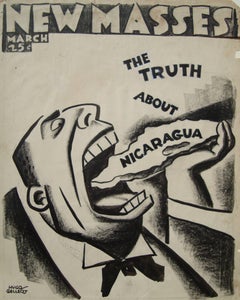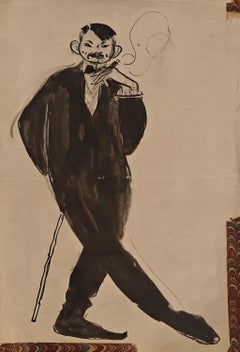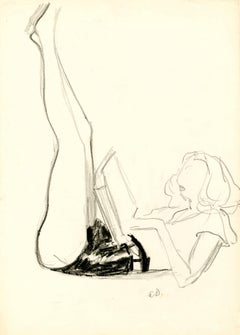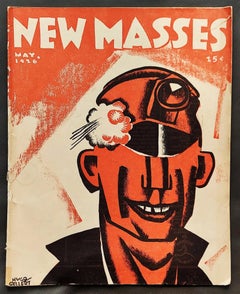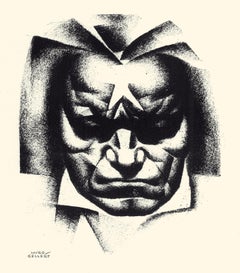Hugo Gellert Art
to
1
Overall Width
to
Overall Height
to
1
1
1
1
1
1
1
1
1
1
7,820
5,167
2,504
1,501
1
Artist: Hugo Gellert
Study for "The New Masses"
By Hugo Gellert
Located in Boston, MA
Hugo Gellert (Hungarian-American, 1892-1985), Study for "The New Masses". Mary Ryan Gallery 4. Signed in ink lower left: "Hugo / Gellert"; inscribed in crayo...
Category
20th Century American Realist Hugo Gellert Art
Materials
Ink, Wax Crayon
Related Items
"Self Portrait / Sketch on verso" Robert Henri, Ashcan Self-Portrait Work
By Robert Henri
Located in New York, NY
Robert Henri
Self Portrait / Sketch on verso
Estate stamped lower right
Ink on paper, graphite on paper
12 1/2 x 8 inches
Born Robert Henry Cozad in Cincinnati, Ohio, Robert Henri became one of the leading personalities in American art, known for his teaching skills, ethnic portraits, especially spirited children, and insistence that artists should adhere to social realism and give rein to their own artistic instincts.
During his growing up years, he lived between Cincinnati and Cozad, Nebraska, founded by his father John Jackson Cozad, a gambler and real estate promoter. When Robert was about 10 years old, his family moved to Cozad in Dawson County. Tension existed between John Cozad and the established ranchers who resented development, and a rancher attacked Cozad, who in self defense shot the man to death.
Fearing for his life, he, his wife and two sons sneaked out of town and re convened in Atlantic City where they disguised their identity by taking other names. The father was later cleared of the charge, but he changed his name to Richard H. Lee, and passed his two sons off as adopted children named Frank Southern and Robert Henri. Robert chose a variation of his middle name to rhyme with "buckeye" to symbolize his Ohio roots. From Atlantic City, as a young man, he attended boarding school in New York City.
He, having shown early art talent, studied at the Pennsylvania Academy of Fine Arts as a student of Thomas Anschutz and Thomas Hovenden...
Category
Early 1900s American Realist Hugo Gellert Art
Materials
Paper, Ink
Eileen Lake
By Adolf Arthur Dehn
Located in Fairlawn, OH
Eileen Lake
Crayon on paper, early1930's
Initialed in pencil lower right (see photo)
Titled and annotated verso "Eileen Lake, early 1930s girlfriend"
Note: Eileen Hall Lake was an American poet and Adolf Dehn's girlfriend in the early 1930s.
Provenance:
Estate of the artist
By descent
Adolf Dehn, American Watercolorist and Printmaker, 1895-1968
Adolf Dehn was an artist who achieved extraordinary artistic heights, but in a very particular artistic sphere—not so much in oil painting as in watercolor and lithography. Long recognized as a master by serious print collectors, he is gradually gaining recognition as a notable and influential figure in the overall history of American art.
In the 19th century, with the invention of the rotary press, which made possible enormous print runs, and the development of the popular, mass-market magazines, newspaper and magazine illustration developed into an artistic realm of its own, often surprisingly divorced from the world of museums and art exhibitions, and today remains surprisingly overlooked by most art historians. Dehn in many regards was an outgrowth of this world, although in an unusual way, since as a young man he produced most of his illustrative work not for popular magazines, such as The Saturday Evening Post, but rather for radical journals, such as The Masses or The Liberator, or artistic “little magazines” such as The Dial. This background established the foundation of his outlook, and led later to his unique and distinctive contribution to American graphic art.
If there’s a distinctive quality to his work, it was his skill in introducing unusual tonal and textural effects into his work, particularly in printmaking but also in watercolor. Jackson Pollock seems to have been one of many notable artists who were influenced by his techniques.
Early Years, 1895-1922
For an artist largely remembered for scenes of Vienna and Paris, Adolf Dehn’s background was a surprising one. Born in Waterville, Minnesota, on November 22, 1895, Dehn was the descendent of farmers who had emigrated from Germany and homesteaded in the region, initially in a one-room log cabin with a dirt floor. Adolf’s father, Arthur Clark Dehn, was a hunter and trapper who took pride that he had no boss but himself, and who had little use for art. Indeed, during Adolf’s boyhood the walls of his bedroom and the space under his bed were filled with the pelts of mink, muskrats and skunks that his father had killed, skinned and stretched on drying boards. It was Adolf’s mother, Emilie Haas Dehn, a faithful member of the German Lutheran Evangelical Church, who encouraged his interest in art, which became apparent early in childhood. Both parents were ardent socialists, and supporters of Eugene Debs. In many ways Dehn’s later artistic achievement was clearly a reaction against the grinding rural poverty of his childhood.
After graduating from high school in 1914 at the age of 19—an age not unusual in farming communities at the time, where school attendance was often irregular—Dehn attended the Minneapolis School of Art from 1914 to 1917, whose character followed strongly reflected that of its director, Munich-trained Robert Kohler, an artistic conservative but a social radical. There Dehn joined a group of students who went on to nationally significant careers, including Wanda Gag (later author of best-selling children’s books); John Flanagan (a sculptor notable for his use of direct carving) Harry Gottlieb (a notable social realist and member of the Woodstock Art Colony), Elizabeth Olds (a printmaker and administrator for the WPA), Arnold Blanch (landscape, still-life and figure painter, and member of the Woodstock group), Lucille Lunquist, later Lucille Blanch (also a gifted painter and founder of the Woodstock art colony), and Johan Egilrud (who stayed in Minneapolis and became a journalist and poet).
Adolf became particularly close to Wanda Gag (1893-1946), with whom he established an intense but platonic relationship. Two years older than he, Gag was the daughter of a Bohemian artist and decorator, Anton Gag, who had died in 1908. After her husband died, Wanda’s mother, Lizzi Gag, became a helpless invalid, so Wanda was entrusted with the task of raising and financially supporting her six younger siblings. This endowed her with toughness and an independent streak, but nonetheless, when she met Dehn, Wanda was Victorian and conventional in her artistic taste and social values. Dehn was more socially radical, and introduced her to radical ideas about politics and free love, as well as to socialist publications such as The Masses and The Appeal to Reason.
Never very interested in oil painting, in Minneapolis Dehn focused on caricature and illustration--often of a humorous or politically radical character. In 1917 both Dehn and Wanda won scholarships to attend the Art Students League, and consequently, in the fall of that year both moved to New York. Dehn’s art education, however, ended in the summer of 1918, shortly after the United States entered World War I, when he was drafted to serve in the U. S. Army. Unwilling to fight, he applied for status as a conscientious objector, but was first imprisoned, then segregated in semi-imprisonment with other Pacifists, until the war ended. The abuse he suffered at this time may well explain his later withdrawal from taking political stands or making art of an overtly political nature. After his release from the army, Dehn returned to New York where he fell under the spell of the radical cartoonist Boardman Robinson and produced his first lithographs. He also finally consummated his sexual relationship with Wanda Gag.
The Years in Europe: 1922-1929
In September of 1921, however, he abruptly departed for Europe, arriving in Paris and then moving on to Vienna. There in the winter of 1922 he fell in love with a Russian dancer, Mura Zipperovitch, ending his seven-year relationship with Wanda Gag. He and Mura were married in 1926. It was also in Vienna that he produced his first notable artistic work.
Influenced by European artists such as Jules Pascin and Georg Grosz, Dehn began producing drawings of people in cafes, streets, and parks, which while mostly executed in his studio, were based on spontaneous life studies and have an expressive, sometimes almost childishly wandering quality of line. The mixture of sophistication and naiveté in these drawings was new to American audiences, as was the raciness of their subject matter, which often featured pleasure-seekers, prostitutes or scenes of sexual dalliance, presented with a strong element of caricature. Some of these drawings contain an element of social criticism, reminiscent of that found in the work of George Grosz, although Dehn’s work tended to focus on humorous commentary rather than savagely attacking his subjects or making a partisan political statement. Many Americans, including some who had originally been supporters of Dehn such as Boardman Robinson, were shocked by these European drawings, although George Grocz (who became a friend of the artist in this period) admired them, and recognized that Dehn could also bring a new vision to America subject matter. As he told Dehn: “You will do things in America which haven’t been done, which need to be done, which only you can do—as far at least as I know America.”
A key factor in Dehn’s artistic evolution at this time was his association with Scofield Thayer...
Category
1930s American Realist Hugo Gellert Art
Materials
Oil Crayon
Pirate Ship - Skull-and-Crossbones Seven Seas Illustration in White and Blue
By Jamie Wyeth
Located in Miami, FL
The Skull-and-Crossbones flag flies atop this illustration of a Pirate Ship. Two palm trees flank it, and it floats in a cropped stylized sea. A single hatted figure is seen looking ...
Category
1970s American Realist Hugo Gellert Art
Materials
Pastel, Ink, Board
Young Love: Walking to School, Four Seasons Calendar Illustration
By Norman Rockwell
Located in Fort Washington, PA
Illustrated for the 1949 Four Seasons Calendar, published by Brown and Bigelow.
A young girl holds a freshly-picked bouquet of flowers as she strolls alongside a boy who carries he...
Category
1940s American Realist Hugo Gellert Art
Materials
Paper, Ink, Watercolor
Three Figures Reading the Torah, Framed Judaica Drawing by Tully Filmus
By Tully Filmus
Located in Long Island City, NY
Tully Filmus (1903 - 1998) was a Russian/American artist who was known for his realist drawings of Jewish life. This pastel drawing on paper is signed low...
Category
Mid-20th Century American Realist Hugo Gellert Art
Materials
Pastel
Two Reclining Nudes, Raphael Soyer
By Raphael Soyer
Located in Fairfield, CT
Artist: Raphael Soyer (1899-1987)
Title: Two Reclining Nudes
Year: Circa 1987
Medium: Watercolor & Pencil Drawing on Archival paper
Size: 17 x 14 inches
Condition: Excellent
Inscript...
Category
1980s American Realist Hugo Gellert Art
Materials
Pastel, Graphite
Environmental Prognostication Coil Narrative "Homo Sapiens R.I.P."
Located in Miami, FL
"They paved paradise and put up a parking lot," Joni Mitchell said. - - Created in 1969, at the dawn of the American environmental movement, artist Richard Erdoes draws a sequential narrative in the form of a coil. From inception to destruction, it illustrates a list of things that humans are doing to destroy the world we live in. The work was commissioned for school-age humans and executed in a whimsically comic way. Yet the underlying narrative is sophisticated and foreshadows a world that could be on the brink of ecological disaster.
Graphically and conceptually, this work exhibits an endless amount of creativity and Erdoes cartoony style is one to fall in love with.
Signed lower right. Unframed 12.4 inches Width: 12.85 inches Height is the live area. Board is 16x22 inches.
Richard Erdoes (Hungarian Erdős, German Erdös; July 7, 1912 – July 16, 2008) was an American artist, photographer, illustrator and author.
Early life
Erdoes was born in Frankfurt,to Maria Josefa Schrom on July 7, 1912. His father, Richárd Erdős Sr., was a Jewish Hungarian opera singer who had died a few weeks earlier in Budapest on June 9, 1912.After his birth, his mother lived with her sister, the Viennese actress Leopoldine ("Poldi") Sangora,He described himself as "equal parts Austrian, Hungarian and German, as well as equal parts Catholic, Protestant and Jew..."[4]
Career
He was a student at the Berlin Academy of Art in 1933, when Adolf Hitler came to power. He was involved in a small underground paper where he published anti-Hitler political cartoons which attracted the attention of the Nazi regime. He fled Germany with a price on his head. Back in Vienna, he continued his training at the Kunstgewerbeschule, now the University of Applied Arts, Vienna.[5] He also wrote and illustrated children's books and worked as a caricaturist for Tag and Stunde, anti-Nazi newspapers. After the Anschluss of Austria in 1938 he fled again, first to Paris, where he studied at the Academie de la Grande Chaumiere, and then London, England before journeying to the United States. He married his first wife, fellow artist Elsie Schulhof (d. xxxx) in London, shortly before their arrival in New York City.
In New York City, Erdoes enjoyed a long career as a commercial artist, and was known for his highly detailed, whimsical drawings. He created illustrations for such magazines as Stage, Fortune, Pageant, Gourmet, Harper's Bazaar, Sports Illustrated, The New York Times, Time, National Geographic and Life Magazine, where he met his second wife, Jean Sternbergh (d. 1995) who was an art director there. The couple married in 1951 and had three children.[6] Erdoes also illustrated many children's books.
An assignment for Life in 1967 took Erdoes to the Pine Ridge Indian Reservation for the first time, and marked the beginning of the work for which he would be best known. Erdoes was fascinated by Native American culture, outraged at the conditions on the reservation and deeply moved by the Civil Rights Movement that was raging at the time. He wrote histories, collections of Native American stories...
Category
1960s American Realist Hugo Gellert Art
Materials
Ink, Gouache, Illustration Board
H 12.4 in W 12.85 in D 1 in
Fillmore East 1968 Traffic, Blue Cheer, Iron Butterfly original artwork
By David Edward Byrd
Located in Southampton, NY
This is the original character study art for the very first Fillmore East concert Poster by David Edward Byrd in 1968, it is featured on page 74 of the new coffee table book "Poster Child, The Psychedelic Art and Technicolor Life of David Edward Byrd". The poster was for a concert at the Fillmore East featuring, Traffic, Blue Cheer and Buttery. An image of the finished poster is shown in this listing just for reference to the figures. David Edward Byrd created some of the most important and memorable Classic Theatre and Rock and Roll images from the 1960s and 70s. David created ALL of the Art for Bill Graham’s Fillmore East, including their Program covers and Rock posters, the art for Jimi Hendrix’s first Fillmore East appearance, The Rolling Stones 1969 World Tour art, The Who’s Performance of Tommy at the New York Metropolitan Opera House and The Fillmore, and The Grateful Dead Swell Dance Concert to name only a few. He also created the poster art for the original location of the 1969 Woodstock music festival . His memorable images were also used for classic Broadway shows like Godspell, Follies and Jesus Christ Superstar to mention only a few. A new coffee table book titled "Poster Child, The Psychedelic Art & Technicolor Life of David Edward Byrd" features his classic Rock and Roll art and Broadway art...
Category
1960s American Realist Hugo Gellert Art
Materials
Ink, Watercolor, Vellum, Pencil
Fiat Wedding Cake Car: Irony And Provocation In Marco Silombria's Pop Art.
Located in Firenze, IT
Fiat Wedding Cake Car: Irony and Provocation in Marco Silombria's Pop Art.
Circa 1970
Artist: Marco Silombria
Technique: Mixed media drawing and collage on paper and cardboard
Dime...
Category
Mid-20th Century Pop Art Hugo Gellert Art
Materials
Paper, Wax Crayon, Ink, Watercolor, Cardboard, Intaglio
Rare 1950s Original Syndicated Ink Drawing Cartoon Strip Susie Q Smith Comic Art
Located in Surfside, FL
SUSIE Q. SMITH
Medium: Newspaper comics
Distributed by: King Features Syndicate
First Appeared: 1945
Creators: Linda and Jerry Walter
6.5 X 18
Like her contemporaries, Aggie Mack, Candy and Patsy Walker (before her conversion to a superhero), Susie Q. Smith was a female Archie-type — not exactly an imitator, because Archie, who had started only four years earlier, hadn't yet become popular enough to spawn imitators, but part of his genre. She attended high school, where her teachers often seemed unreasonable to her, interacted with the opposite gender in a typically adolescent way, and her parents didn't completely understand her. And she was cute and perky as only a teenage girl can be.
Susie was the star of a comic strip distributed by King Features, the biggest of the comic strip syndicates, whose other offerings have ranged from Jackys Diary to Prince Valiant. King launched the strip in both daily and Sunday form in 1945. Daily, she was only in a panel at first, but it expanded into a full, multi-panel strip on February 7, 1953. In a very odd turn of events, in 1953 the Walters chose to leave King Features behind and hitch their wagon at the McNaught Syndicate. The creators were Harold "Jerry" Walter and his wife, Linda. Jerry was also responsible for Jellybean Jones, who has nothing to do with Jughead Jones's young sister, a modern-day addition to the Archie cast of characters. Together, they did The Lively Ones during the 1960s. Though each was capable of doing both major jobs in comic strip production, their usual working method was for Jerry to dream up the ideas and write the dialog, while Linda did the artwork.
The Walters also collaborated on a series of Susie Q. Smith comic books for Dell Comics. Instead of reprinting newspaper strips, these ran new stories by the Walters. Between 1951 and '54, four issues were published as part of the Four Color Comics series, where many minor comic strips, including Dotty Dripple, Timmy and Rusty Riley had found a home. It had no other media spin-offs.
Susie Q. Smith had a respectable run in the newspapers, but it ended in 1959.
Jerry Walter (1915 - 2007) was an abstract expressionist artist whose output of energetic and colorful paintings were the products of the rich artistic milieu of post-war New York City. He was born Harold Frank Walter in Mount Pleasant, Iowa on November 25, 1915. After graduating from Colgate University in 1937, Walter moved to New York City, where he studied drawing and painting at the New School and the Art Students’ League. Before concentrating seriously on his art, he spent several years as a successful copywriter and idea man for the advertising agencies of J. Walter Thompson, McCann Ericson, and BBDO. During this time, he also worked as a syndicated cartoonist. Collaborating with his wife, Linda, his best-known series was Susie Q. Smith, which first appeared in 1945 and described as a “female Archie type.” Very popular, the cartoon was later the subject of a series of comic books published from 1951 to 1954. After serving in the United States Army for three years during World War II, Walter began to paint seriously. He ascribed his earliest artistic influence to Joan Miró, whose Dog Barking at the Moon (1926) he viewed when he was twelve, the year he published his first cartoon. Walter later wrote that jazz, “the first native expression of so-called modernism” was a strong influence on his work.
During the later 1940s, Walters spent time at the Research Studio in Maitland, Florida. Founded in 1937 by artist and architect J. André Smith and supported by the philanthropist Mary Curtis Bok, the Research Studio was a lively colony that hosted prominent artists, including Milton Avery, Ralston Crawford, and Doris Lee. While at the Studio, Walter’s work was purchased by Frank Crowninshield. A founding trustee of the Museum of Modern Art and editor of Vanity Fair, Crowinshield was a noted collector; his collection included important works by Pablo Picasso, Marc Chagall, Henri Matisse, Edgar Degas, George Bellows, and Pierre Bonnard. Returning to New York after his time at the Studio, Walter became an active member of the New York school of the abstract expressionist movement, and in the summer of 1956, Walter exhibited 13 paintings and a selection of drawings at New York’s Chase Gallery. The adroit manipulation of both color and composition evident in his work shows the influence of Abstract Expressionism, particularly Willem de Kooning, Arshile Gorky, and Hans Hofmann.
illustrator and female cartoonist Linda Walter was the talented female mind behind the beloved "Susie Q. Smith" comic strip. She played an instrumental role in shaping the cultural landscape through her vibrant illustrations. Known for the timeless charm of the "Susie Q. Smith" comic strip, Linda's artistry brought joy and laughter to countless readers during the 1950s and continues to resonate with fans across generations. She was part of the Woodstock artists community. from Women in Comics: Linda Walter was the artist of newspaper strip Susie Q. Smith, which was written by her husband, Jerry. It was syndicated by King Features Syndicate and ran from 1945 to 1959. The Walters also contributed original Susie Q. Smith stories to Dell's Four Color comic books from 1951 to 1954. From 1964-1965, they created a singled panel comic called The Lively Ones.
Vintage Golden Age of Comics era.
The Golden Age of Comic Books describes an era in the history of American comic books from 1938 to 1956. During this time, modern comic books were first published and rapidly increased in popularity. The superhero archetype was created. Between 1939 and 1941 Detective Comics (DC) and its sister company, All-American Publications, introduced popular superheroes such as Batman and Robin, Wonder Woman, the Flash, Green Lantern, Doctor Fate, the Atom, Hawkman, Green Arrow and Aquaman. Timely Comics, the 1940s predecessor of Marvel Comics, had million-selling titles featuring the Human Torch, the Sub-Mariner, and Captain America. Another notable series was The Spirit by Will Eisner.
Dell Comics' non-superhero characters (particularly the licensed Walt Disney animated-character comics) outsold the superhero comics of the day. The publisher featured licensed movie and literary characters such as Mickey Mouse, Donald Duck, Roy Rogers and Tarzan. Additionally, MLJ's introduction of Archie Andrews in Pep Comics #22 (December 1941) gave rise to teen humor comics, with the Archie Comics...
Category
1950s American Realist Hugo Gellert Art
Materials
Paper, Ink
Cycling. Two men Sports Racing on Bicycles
By Bob Peak
Located in Miami, FL
This illustration was commissioned for the 1984 Olympic Games by the US postal service.
Signed and dated lower right
Work is framed
framed under acrylic to an overall size of 31.5 ...
Category
1980s American Realist Hugo Gellert Art
Materials
Pastel, Watercolor
"Dragon, " Original Pastel Drawing
By Quang Ho
Located in Denver, CO
"Dragon," by Quang Ho, is a secondary market work with one previous owner. It is signed and dated (1988) on the lower left. The painting comes with it's original frame (measures 50 x...
Category
20th Century American Realist Hugo Gellert Art
Materials
Paper, Pastel
Previously Available Items
"New Masses" Vol 1, No 1, May 1926, Actual Magazine, VG Condition Hugo Gellert
By Hugo Gellert
Located in New York, NY
"New Masses" Vol 1, No 1, May 1926, Actual Magazine, VG Condition Hugo Gellert
New Masses Magazine. May 1926, Inaugural: Vol 1, No 1. Published by the New Masses Inc., 39 West 8th St., New York City.
New Masses (1926-1948) was an American Marxist magazine launched in New York City. It was closely associated with the Communist Party USA. With the coming of the Great Depression in 1929 America became more receptive to ideas from the political Left and New Masses became highly influential in intellectual circles. The magazine has been called the principal organ of the American cultural left from 1926 onwards. It featured the work of an array of independent writers and artists.
The Metropolitan Museum of Art’s recent exhibition, “Art for the Millions: American Culture and Politics in the 1930s” celebrated the American spirit during the depression era. In the exhibition several issues of "New Masses" are exhibited, but not Vol 1. No. 1. We offer that.
Lithograph by Hugo Gellert on the cover and multiple illustrations in magazine. Hugo Gellert (1892-1985) was a Hungarian-American illustrator and muralist. A committed radical and member of the Communist Party of America, Gellert is considered by some art critics as among the best political work of the first half of the 20th century.
The artists who works are inside Vol 1, No. 1 include: William Gropper, Adolph Dehn, Stuart Davis, Art Young, I. Klein, Boardman Robinson, Wanda Gag, Louis Lozowick, F. S. Hynd, New Masses, Otto Soclow, Hans Stengel and Arnold Ronnebeck.
The writers included in this issue: Babette Deutsch, Robert Dljnn, Robinson Jeffers, William Carlos Williams, Nathan Asch, Norman Studer, M. H. Hedges, Art Shields, Karol Rembov, Hal Saunders-White, Edwin Seaver, George Sterling, Scott Nearing and Whittaker Chambers.
Editors: Egmont Arens, Joseph Freeman, Hugo Gellert, Michael Gold, James Rorty, and Joan Sloan.Executive Board: Egmont Arens, Maurice Becker, Helen Black, John Dos Passos, Robert Dunn...
Category
1920s American Modern Hugo Gellert Art
Materials
Paper
Ludwig Van Beethoven
By Hugo Gellert
Located in Myrtle Beach, SC
A fine, richly-inked impression, on cream laid paper; the full sheet (19 3/4 x 16 inches) with wide margins, in excellent condition. Signed in pencil, lower left. Scarce.
A powerfu...
Category
1920s American Modern Hugo Gellert Art
Materials
Lithograph
MODERN SCIENCE FOR ALL
By Hugo Gellert
Located in Santa Monica, CA
HUGO GELLERT (1892 - 1985)
MODERN SCIENCE FOR ALL, 1943
Screenprint, signed in pencil lower left. Edition 54. Image 15 x 13 inches. Full margins,
fold...
Category
1940s American Modern Hugo Gellert Art
Materials
Screen
FREE MAN'S DUTIES, No 4
By Hugo Gellert
Located in Santa Monica, CA
HUGO GELLERT (1892 - 1985)
FREE MAN'S DUTIES N0. 4
Screenprint, signed in pencil lower left. Edition 54. Image 15 x 13 inches. Full margins,
folded sh...
Category
1940s American Modern Hugo Gellert Art
Materials
Screen
Hugo Gellert art for sale on 1stDibs.
Find a wide variety of authentic Hugo Gellert art available for sale on 1stDibs. You can also browse by medium to find art by Hugo Gellert in crayon, ink, paper and more. Much of the original work by this artist or collective was created during the 20th century and is mostly associated with the modern style. Not every interior allows for large Hugo Gellert art, so small editions measuring 11 inches across are available. Customers who are interested in this artist might also find the work of Emil Bisttram, George Biddle, and Frank Wootton. Hugo Gellert art prices can differ depending upon medium, time period and other attributes. On 1stDibs, the price for these items starts at $2,950 and tops out at $8,250, while the average work can sell for $5,600.
